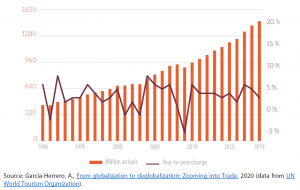Initially, the overall trend of slowbalisation did not appear to extend to the social realm, where digitalisation and the emergence of new middle classes in Asia have widened and deepened global integration. The tourism industry has for decades been one of the key engines of globalisation, contributing to social exchanges and physical movement, as well as economic globalisation. Tourism represents an important export service for many economies and about 10 % of global GDP and jobs. Between 2000 and 2018, the number of international tourists worldwide has more than doubled (see Figure 9). At the same time, economic crises have negatively impacted tourism, as seen in 2003 and 2009. In general, travel, transport and related services represented an important share of global service exports, and were, at 5 % on average, growing faster than the annual real growth of global economy.
The onset of the Covid 19 pandemic and social distancing measures reversed the trend in cross-border movements dramatically. The pandemic had a proportionately greater impact on international tourism than other global economic shocks of past decades. In the first quarter of 2020, international tourist arrivals already fell by 22 %, and according to the World Tourism Organization (UNWTO), international tourism is set to decrease by 60-80 % overall in 2020. As many tourists are opting to travel closer to home, the intercontinental air and cruise ship sectors are being severely affected and will likely take a longer time to rebound compared to most other economic sectors, marking the beginning of a slowdown in the arena of social exchanges.








Be the first to write a comment.